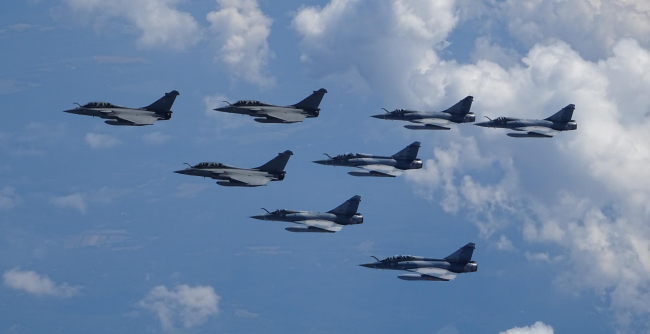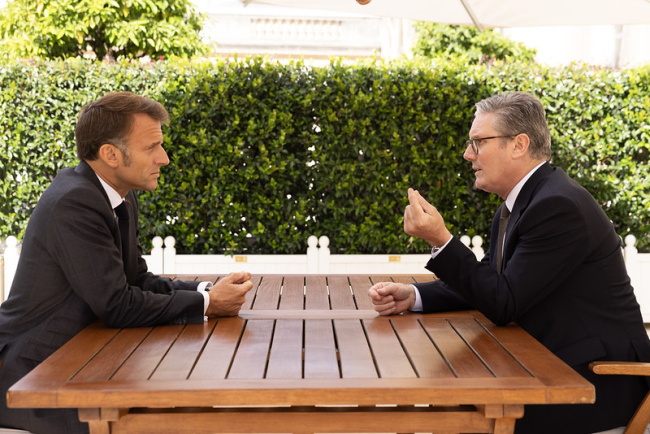Le retour de la haute intensité en Ukraine : quels enseignements pour les forces terrestres ?

After twenty years of counter-terrorism, the Ukrainian battlefield marks the renewal of so-called “high-intensity” warfare. It constitutes a major strategic turning point, reversing the contemporary model of wars involving the West.

This massive invasion of a country by a powerful conventional army is largely played out on the ground. It sheds light on the preparation of ground forces for a major engagement hypothesis. For the Ukrainians, the war corresponds to a high-intensity conflict, both political, because it involves their vital interests, and capability-based, mobilizing all of their military means. For Russia, on the other hand, the high intensity is more about capabilities than politics.
This conflict is taking place in the form of a linear war characterized by a reemergence of the front, a phenomenon that has become rare, although it has already resurfaced in Syria and Iraq. As in these theaters, the war in Ukraine confirms that cities remain the priority areas, justifying the efforts made by the French Army to train in this environment. Urban warfare requires high material capabilities in terms of fire, manpower and logistics, but also moral strength. In this respect, the Ukrainian conflict reminds us of the role played by the population, mobilized in support of the defense apparatus. The high attrition rate raises the question of human losses and the “tolerance threshold” if France were to be engaged on battlefields with a similar lethality.
High intensity characteristics have an impact on all operational functions.
- The first issue is military intelligence. The dissemination and exploitation of OSINT (Open Source Intelligence) information, the use of video surveillance cameras and civilian mini-drones are all innovations that have been adapted to the military field.
- Mastering the combined arms maneuver is decisive in this engagement, with the heavy segment at its center, which has become the symbol of high intensity. Faced with the return of a significant adversary in the air and the wide spectrum of threats evolving in the low layer (UAVs, helicopters, missiles, rogue munitions, indirect fires), the reduction of the French Army’s ground-to-air defense capabilities represents a vulnerability.
- To succeed in the maneuver, an efficient and agile C2 is essential. The Ukrainian experience shows that the resilience of the C2 of an air-land component depends on an organization designed to delegate execution at the operational and tactical levels as much as possible. Therefore, integrating effects of other environments and fields must be possible until the lowest levels.
- Finally, the Ukrainian example is a timely reminder of the place of immaterial fields in high intensity. Permanent access to a mobile Internet as close as possible to the battlefield and in all its depths has proven to be an essential asset in terms of informational warfare.
The Ukrainian conflict and its repercussions on strategic stability in Europe highlight the role played by ground forces in “winning the war before the war”. It implies a reinvestment in the functions of “deterrence” but also “prevention” through strategic signals such as participation in the reassurance of North Atlantic Treaty Organization (NATO)’s eastern flank. Each military exercise must be thought of as a display of will. For greater credibility, it is necessary to maintain a high level of training of armed forces. Having a unique operational experience among European armies in this field, France must invest fully in the military structures of NATO and the European Union.
This signaling is also embodied in the readiness actions of foreign forces through Partnered Military Operations (PMOs). In certain politically sensitive contexts, special forces can play a unique role in implementing this type of partnership in a discreet manner.
It is essential to guarantee freedom of action through sufficient mass. From this perspective, weapons deliveries to Ukraine raise three questions: the impact of sending in-service equipment such as Caesars on the French order of battle; possible technology transfers linked to the delivery of modern equipment; and the ex-post control and monitoring of these weapons deliveries.
Finally, the triple surprise of the Russian offensive, the Ukrainian resistance and the scale of the international reaction testify the need to appropriate the adversary’s rationality and the difficulty of anticipating his reactions. Acting as a strategist in the face of systemic competitors requires sustained efforts in the field of “knowledge and anticipation”.
This content is available in French: "Le retour de la haute intensité en Ukraine : quels enseignements pour les forces terrestres ?".

Available in:
Regions and themes
Share
Related centers and programs
Discover our other research centers and programsFind out more
Discover all our analysesSaudi Arabia’s Nuclear Temptations. Lessons Learned from Regional Instability
Saudi Arabia’s integration in the international arena and regional stability, notably through reducing its dependence on fossil energies, are crucial elements for the success of the Kingdom’s Vision 2030, the Crown Prince’s top priority. However, Mohammed bin Salman’s declarations in 2018 and 2021, indicating that “if Iran develops a nuclear bomb, we will follow suit as soon as possible”, combined with the recent strikes on key Iranian nuclear facilities, do not bode well for the future of the Kingdom, the region and the non-proliferation regime at large.
The Future of Air Superiority. Command of the Air in High Intensity Warfare
Air superiority, understood as control of the air, is a cornerstone of the Western art of warfare. It is a decisive condition, albeit not sufficient by itself, to achieve military victory, as it enables the concentration of air power toward the achievement of wider strategic objectives and protects other components from unbearable attrition levels. It is best achieved through the offensive use of air power in a joint effort to neutralize the enemy’s air power.
Europe Uncovered?
As Russia continues to threaten Europe, the Trump administration is making no secret of its desire to withdraw—at least partially—from the defense of the Old
Continent in order to focus on strategic competition with China. It is thus putting pressure on its European allies to increase their investment in the military sector. The NATO Summit in The Hague in June 2025 resulted in ambitious commitments by member states to increase their defense spending.
How should Britain and France cooperate to realise the Northwood Declaration?
During his state visit to the United Kingdom (UK) last week, Emmanuel Macron, President of France, signed a joint declaration with Sir Keir Starmer, Prime Minister, on nuclear cooperation between Britain and France. The Northwood Declaration highlights that while both countries’ nuclear arsenals remain sovereign, cooperation on nuclear deterrence can ‘contribute significantly’ to the security of the North Atlantic Treaty Organisation (NATO) and the Euro-Atlantic region.













